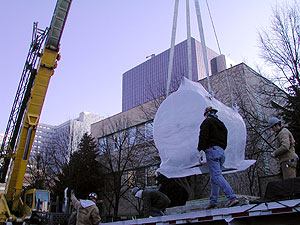|
Audio
Photos
Your Voice
|
A big magnet to study a small world
February 28, 2003
 |
| The magnet weighs 8,000 pounds, and is the most powerful magnet used for medical research in the world. (MPR photo/Rob Schmitz) |
Rochester, Minn. — Scientists measure extremely powerful magnets in Teslas. An MRI uses a 3 Tesla-strength magnet. But the Mayo's new magnet is a one-of-a-kind, 12 Tesla-strength magnet. Researchers say its 240,000 times more powerful than the Earth's magnetic field, and is the highest Tesla magnet currently in use for medical research.
A construction crew needed a crane to lift the 8,000 pound magnet into Mayo's Spectrometry Laboratory. It's only the size of a refrigerator and is solid apart from a cylindrical tube bored into its center.
 | |||
That's where researchers will place cell and protein samples.
The scientists will break cells to release their proteins and then weigh them. By knowing the weight, they can identify defective proteins, helping them in their search for the cures to the world's most common incurable diseases.
"We're looking at Huntington's Disease, we're looking at ovarian cancer, we're looking at prostrate cancer, we're looking at new vaccines for smallpox, for anthrax, the list goes on," says Dr. David Muddiman, director of Mayo's Spectrometry Laboratory,"So basically, this technology is very comprehensive and can look at almost anything."
Muddiman says the challenge in understanding proteins in cells is that they're hard to look at with available technology. Currently, researchers are limited to examining minute amounts in any detail. For example, a cell is made up of a million to five million separate components, all containing proteins.
"The problem with current technologies are that they can only look at a thousand to two thousand of those at a given time," Muddleman says. "We're going to be able to actually look at all of those components over the course of a day in a given individual to actually try to learn about a specific disease."
Muddiman is confident the sheer power of the new magnet will result in more work for his researchers and more money in the future for his lab. The magnet, which was specially made in England, costs two million dollars. Once the magnet is installed, it will take two weeks to reach full power.
|
News Headlines
|
Related Subjects
|
